This article was co-authored by Ray Spragley, DVM. Dr. Ray Spragley is a Doctor of Veterinary Medicine and the Owner/Founder of Zen Dog Veterinary Care PLLC in New York. With experience in multiple institutions and private practices, Dr. Spragley’s specializations and interests include non-surgical management of cranial cruciate ligament tears, Intervertebral Disk Disease(IVDD), and pain management in osteoarthritis. Dr. Spragley holds a BS in Biology from SUNY Albany and has a Doctor of Veterinary Medicine degree (DVM) from Ross University School of Veterinary Medicine. He is also a Certified Canine Rehabilitation Therapist (CCRT) through the Canine Rehab Institute as well as a Certified Veterinary Acupuncturist (CVA) through Chi University.
There are 9 references cited in this article, which can be found at the bottom of the page.
wikiHow marks an article as reader-approved once it receives enough positive feedback. In this case, 100% of readers who voted found the article helpful, earning it our reader-approved status.
This article has been viewed 164,610 times.
Dogs can suffer from neck pain, just like humans. The cause of neck pain can range from an innocuous muscular sprain, to disc disease, meningitis, or neurological disorders such as syringomyelia (SM).[1] How you treat your dog's neck pain will depend on the cause of his symptoms, so it's important to get an accurate diagnosis. Take your dog to see your veterinarian as soon as you notice any signs of neck pain in your pet.
Veterinarian Pippa Elliott MRCVS suggests caution: "If you suspect a dog has neck pain, it's best to be cautious and be gentle with their neck. Avoid a collar, and instead use a harness. Raise the food and water bowls a little off the floor, and lift the dog rather than expect them to jump into the car."
Steps
Treating Neck Pain Caused By Injury
-
1Evaluate your dog's injury. Dog's can suffer from whiplash and neck sprain quite easily. Anything from a sudden halting brake during a car ride to jerking his head around playing catch or running with other dogs could have caused your pet to experience some neck pain.[2]
-
2Schedule a check up. Your vet will want to run tests and may require X-rays, CT scans, or an MRI to rule out any more serious conditions. It's important to rule out those conditions, as many debilitating illnesses and infections that cause neck pain require quick medical treatment. Even a severe spinal trauma may require corrective surgery.[3]Advertisement
-
3Administer supportive care. If your dog is suffering from a sprained neck, your vet may prescribe muscle relaxants and anti-inflammatory medication to treat the pain and facilitate movement. Allow your dog plenty of time to rest and recover.[4]
- Do not be tempted to give human pain relief medication to your dog unless instructed to do so under veterinary supervision.
Treating Neck Pain Caused By Lyme Disease
-
1Identify the symptoms of Lyme disease. Lyme disease is caused by a bacterium called Borrelia burgdorferi, which is transmitted to a host (in this case, a dog) through a tick's bite. Ticks can thrive in many different environments in North America and Europe.[5] If your dog has been through a grassy field or a forested area, he may have picked up a tick. While the trademark "bulls eye" rash is an easy indicator in humans, it does not show up on animals, which may make this disease more difficult to diagnose in dogs.[6] Common symptoms include:
-
2Administer antibiotics. Lyme disease cannot be treated without proper veterinary care. Your veterinarian will be able to give you the antibiotics your pet needs to fight the disease and start feeling better. Some of the more commonly prescribed antibiotics are doxycycline, tetracycline and amoxicillin.[12]
- Your dog will most likely need to take antibiotics every day for around one month. Your vet may recommend extending or shortening the treatment length. Follow your veterinarian's advice and ask questions if you're unsure of how or when to administer antibiotics.[13]
-
3Check your dog often for ticks. Dogs who frequent wooded or grassy areas should be checked for ticks often. To check a dog for ticks, run through the following list:
- Run your fingers over the entire length of your dog's body. Check hard-to-see places like armpits, between toes, and behind ears.[14]
- Look for bumps or raised spots. Any time you find a raised spot, pull the fur apart to inspect the bump. Use a magnifying glass if you need to. If you see a tiny spot with eight legs, it is most likely a tick.[15]
-
4Remove ticks whenever you find one. It's important to act fast, as ticks can transmit disease to their hosts within 24 hours of contact.[16] To safely remove a tick from your dog:
- Use a clean pair of tweezers to grasp the tick's head, as close to your dog's skin as possible. You may wish to wear disposable gloves to reduce the likelihood of infection to yourself.[17]
- Pull the tick straight out of the skin. If the tick breaks apart, be sure to remove any pieces left behind, as these may also transmit Lyme disease.[18]
Treating Neck Pain Caused By Meningitis
-
1Identify the symptoms of meningitis. Meningitis is an infection (usually viral) that causes an inflammation of the meninges, the membranes surrounding the brain and spinal cord. It can affect any breed of dog, but some dog breeds inherit breed-specific forms of meningitis, and it is not known how or why this happens. Some breeds known to inherit this disease are beagles, Bernese mountain dogs, pugs, and Maltese terriers. Common symptoms of canine meningitis include:
- Fever
- Neck pain
- "Stiff" neck and rigidity (difficulty moving the head and neck)
- Weakness in the legs
- Loss of balance/equilibrium
- Seizures
-
2Administer medication. Meningitis cannot be treated without proper veterinary care. The most common course of action is to suppress the immune response, typically through high doses of steroid treatment. Prednisone is commonly prescribed for dogs with meningitis, though your vet may prescribe other medications, either with or without prednisone.
-
3Watch for signs of relapse. Canine meningitis is rarely curable, and while treatment options can reduce the symptoms and improve a dog's quality of life in the short term, relapses are quite common, and may be fatal. Alert your veterinarian of any signs of relapse in your pet.
Treating Neck Pain Caused By Cervical Disc Disease
-
1Identify the symptoms of cervical disc disease. Cervical disc disease, also known as a slipped disc, tends to happen as dogs age. Typically discs "slip" in one of two ways: disc extrusion, in which the nucleus pulposus slips out from the center of a vertebra and causes damage to the spinal cord, or disc protrusion, in which the fibrous ring around vertebrae grow thicker, causing the spinal cord to painfully contract.[19] Typical symptoms include:
-
2Get a diagnosis. A veterinarian is the only person who can diagnose cervical disc disease. He will probably take X-rays of the neck and spine to determine whether a disc extrusion or protrusion is the cause of your dog's pain.[29]
-
3Give your dog supportive care. Unless your vet recommends surgery to correct the slipped disc, the best way to treat cervical disc disease is through supportive care.[30]
Treating Neck Pain Cause By Wobbler's Syndrome
-
1Identify the symptoms of Wobbler's syndrome. Wobbler's disease is a painful ailment found in many large dog breeds, such as Dobermans, Great Danes, and mastiffs, and is caused by either a slipped or herniated disc, or by a bony deformity around the spinal cord.[33] The name Wobbler comes from the short, "wobbly" stride of dogs afflicted with this disease.[34] Typical symptoms of Wobbler's syndrome include:
-
2Get a diagnosis. Your veterinarian will most likely order X-rays, a CT scan, or an MRI in order to diagnose whether or not your dog has Wobbler's syndrome. Depending on the severity of your dog's condition, your vet may recommend surgery.[40]
-
3Give your dog supportive care. Unless your vet orders surgery to correct the problem, the best thing you can do is make your dog comfortable. Administer any medications your vet prescribes to treat inflammation and swelling in the neck and spine. You will also need to reduce your dog's activity. Some vets recommend keeping dogs with Wobbler's syndrome confined to a crate in order to let the dog rest and restrict his movement.[41]
- If your vet diagnoses your dog with Wobbler's syndrome, you will need to use a harness for walking him instead of a leash. Do not keep a collar on your dog's neck if he is diagnosed with Wobbler's disease.[42]
-
4Consider physical therapy. Some veterinary clinics offer water therapy and acupuncture as part of a holistic rehabilitation therapy. Talk to your vet about what may work best for your dog.[43]
Making Your Dog’s Life More Comfortable
-
1Use a harness to walk your dog. If your dog is suffering from any kind of neck pain, a collar may cause too much strain and discomfort on his neck and spine. A harness can be a useful alternative, as it spreads pressure over his chest and does not put any strain on your dog's neck. Avoid using a collar, and opt for unleashed, fenced-in yard time whenever possible instead of walking your dog on a leash.[44]
-
2Use a heating pad. Heat therapy is a useful tool in relieving mild neck discomfort, especially in dogs with arthritis.[45]
- Follow the directions bag's packaging and heat for the appropriate time. Then speak calmly to the dog, encourage him to lie down, and place the bag over his neck for a period of five to ten minutes at a time.
-
3Make food and water more easily accessible. If your dog is suffering from neck pain, he may have a hard time lowering his head to eat and drink out of his bowl if you keep it on the floor. Keep your dog's bowl elevated to a height that allows him to eat and drink without having to bend and stoop.[46]
-
4Monitor any deterioration in your dog’s mobility. It is important when managing neck pain to be alert for any deterioration in the dog's mobility. Neck pain is often a warning sign of other impending health problems, so it's important to determine and treat the cause of the pain, rather than just the pain itself.
- Any dog with neck pain should be rested as movement is likely to make the pain worse. If the dog has other symptoms, such as if he goes off his food, then a vet check is essential.
References
- ↑ https://www.vetinfo.com/dog-neck-pain.html
- ↑ https://www.vetinfo.com/dog-neck-pain.html
- ↑ https://www.vetinfo.com/dog-neck-pain.html
- ↑ https://www.vetinfo.com/dog-neck-pain.html
- ↑ http://www.mayoclinic.org/diseases-conditions/lyme-disease/basics/definition/con-20019701
- ↑ http://www.vcahospitals.com/main/pet-health-information/article/animal-health/lyme-disease-in-dogs/837
- ↑ http://www.drschoen.com/lyme-disease-fact-from-fiction/
- ↑ http://www.drschoen.com/lyme-disease-fact-from-fiction/
- ↑ http://www.drschoen.com/lyme-disease-fact-from-fiction/
- ↑ http://www.drschoen.com/lyme-disease-fact-from-fiction/
- ↑ http://www.drschoen.com/lyme-disease-fact-from-fiction/
- ↑ http://www.drschoen.com/lyme-disease-fact-from-fiction/
- ↑ http://www.drschoen.com/lyme-disease-fact-from-fiction/
- ↑ http://www.humanesociety.org/animals/dogs/tips/getting_ticks_off_dog.html?referrer=https://www.google.com/
- ↑ http://www.humanesociety.org/animals/dogs/tips/getting_ticks_off_dog.html?referrer=https://www.google.com/
- ↑ http://www.humanesociety.org/animals/dogs/tips/getting_ticks_off_dog.html?referrer=https://www.google.com/
- ↑ http://www.humanesociety.org/animals/dogs/tips/getting_ticks_off_dog.html?referrer=https://www.google.com/
- ↑ http://www.humanesociety.org/animals/dogs/tips/getting_ticks_off_dog.html?referrer=https://www.google.com/
- ↑ http://www.willows.uk.net/specialist-services/pet-health-information/veterinary-neurology/cervical-disc-disease
- ↑ http://www.willows.uk.net/specialist-services/pet-health-information/veterinary-neurology/cervical-disc-disease
- ↑ http://www.willows.uk.net/specialist-services/pet-health-information/veterinary-neurology/cervical-disc-disease
- ↑ http://www.willows.uk.net/specialist-services/pet-health-information/veterinary-neurology/cervical-disc-disease
- ↑ http://www.willows.uk.net/specialist-services/pet-health-information/veterinary-neurology/cervical-disc-disease
- ↑ http://www.willows.uk.net/specialist-services/pet-health-information/veterinary-neurology/cervical-disc-disease
- ↑ http://www.veterinarypartner.com/Content.plx?A=2785
- ↑ http://www.veterinarypartner.com/Content.plx?A=2785
- ↑ http://www.willows.uk.net/specialist-services/pet-health-information/veterinary-neurology/cervical-disc-disease
- ↑ http://www.veterinarypartner.com/Content.plx?A=2785
- ↑ http://www.willows.uk.net/specialist-services/pet-health-information/veterinary-neurology/cervical-disc-disease
- ↑ http://www.willows.uk.net/specialist-services/pet-health-information/veterinary-neurology/cervical-disc-disease
- ↑ http://www.willows.uk.net/specialist-services/pet-health-information/veterinary-neurology/cervical-disc-disease
- ↑ http://www.willows.uk.net/specialist-services/pet-health-information/veterinary-neurology/cervical-disc-disease
- ↑ http://www.huffingtonpost.com/dr-karen-becker/wobblers-syndrome_b_1615852.html
- ↑ http://www.huffingtonpost.com/dr-karen-becker/wobblers-syndrome_b_1615852.html
- ↑ http://www.huffingtonpost.com/dr-karen-becker/wobblers-syndrome_b_1615852.html
- ↑ http://www.huffingtonpost.com/dr-karen-becker/wobblers-syndrome_b_1615852.html
- ↑ http://www.huffingtonpost.com/dr-karen-becker/wobblers-syndrome_b_1615852.html
- ↑ http://www.huffingtonpost.com/dr-karen-becker/wobblers-syndrome_b_1615852.html
- ↑ http://www.huffingtonpost.com/dr-karen-becker/wobblers-syndrome_b_1615852.html
- ↑ http://www.huffingtonpost.com/dr-karen-becker/wobblers-syndrome_b_1615852.html
- ↑ http://www.huffingtonpost.com/dr-karen-becker/wobblers-syndrome_b_1615852.html
- ↑ http://www.huffingtonpost.com/dr-karen-becker/wobblers-syndrome_b_1615852.html
- ↑ http://www.huffingtonpost.com/dr-karen-becker/wobblers-syndrome_b_1615852.html
- ↑ http://www.huffingtonpost.com/dr-karen-becker/wobblers-syndrome_b_1615852.html
- ↑ http://vetmedicine.about.com/od/diseasesandconditions/a/CW-DogArthritisCare.htm
- ↑ http://vetmedicine.about.com/od/diseasesandconditions/a/CW-DogArthritisCare.htm
About This Article
To treat neck pain in your dog, try covering its neck with a heating pad for 5-10 minutes at a time to relieve the pain and discomfort. Additionally, use a harness when you walk your dog, instead of a collar and leash, to avoid putting any strain on its neck. You should also elevate its food and water bowls so it doesn’t have to bend its neck as much in order to eat and drink. Along with these measures, make sure to monitor your dog’s condition and take it to the vet if you notice symptoms like incontinence or loss of appetite. For more advice from our Veterinary co-author, including how to identify illnesses like meningitis and cervical disc disease, keep reading.

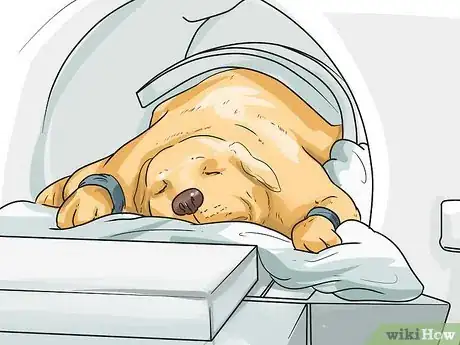
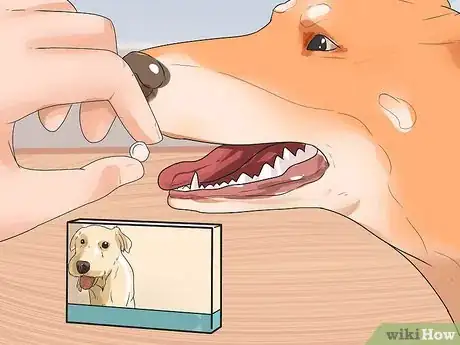
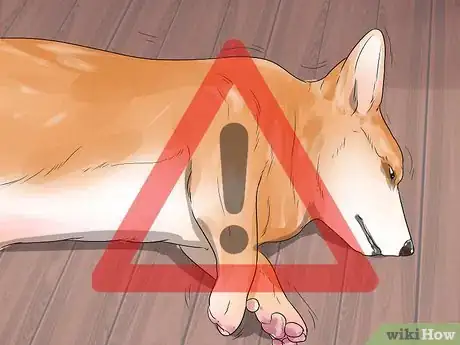
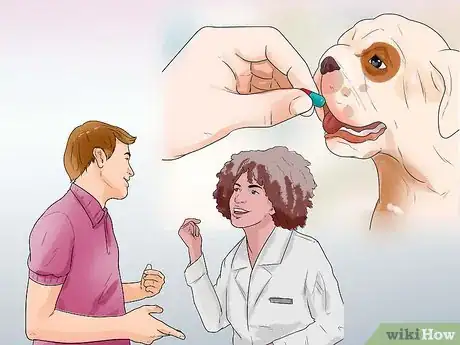
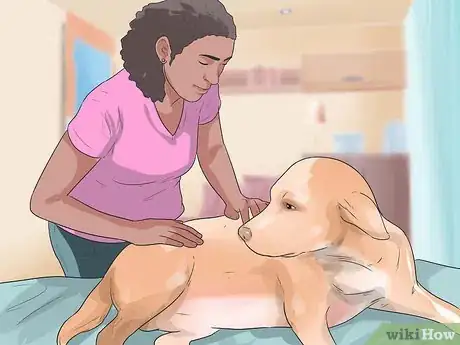
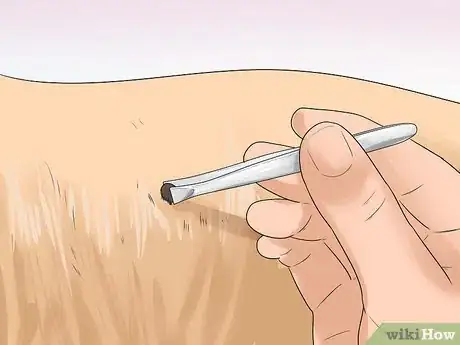
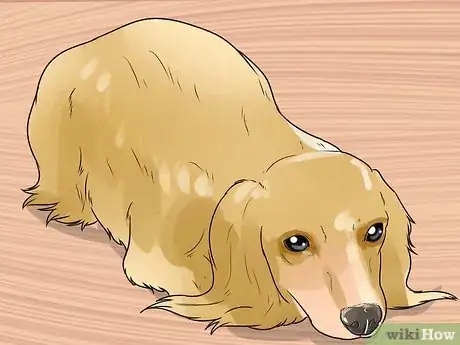
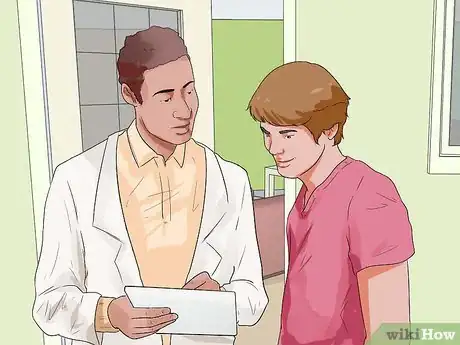
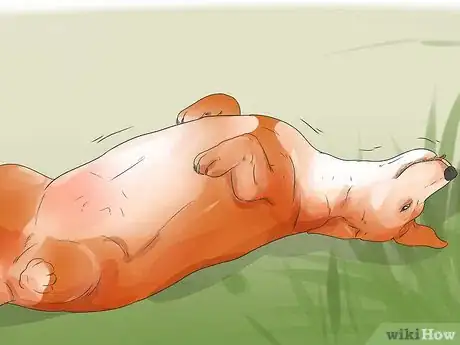
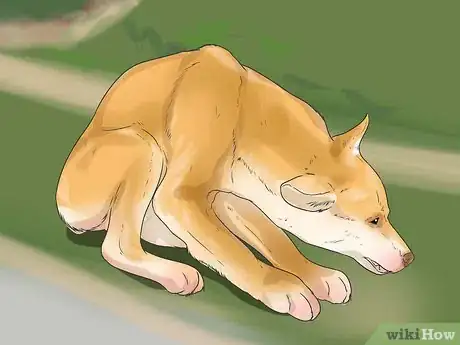
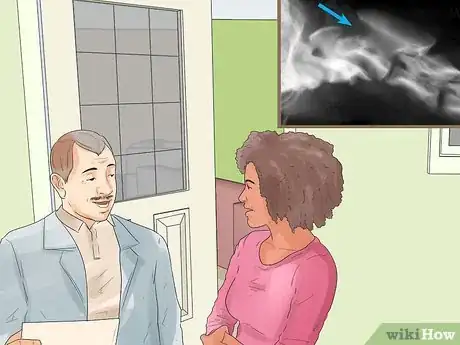


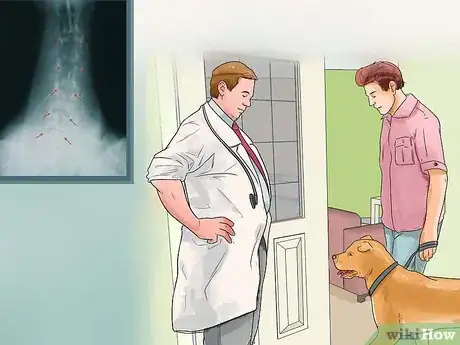
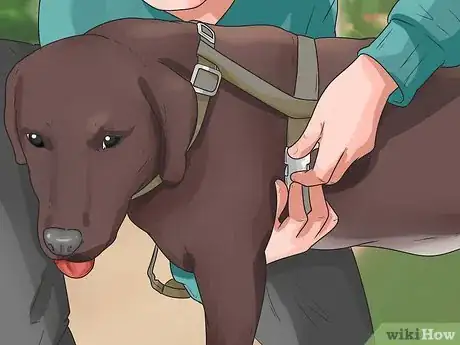
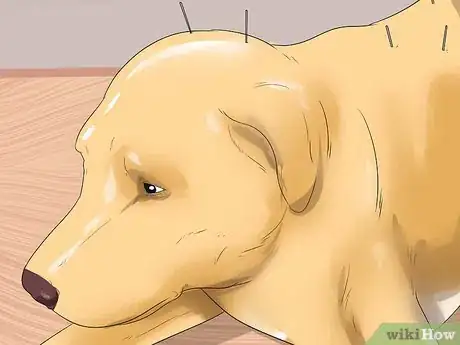
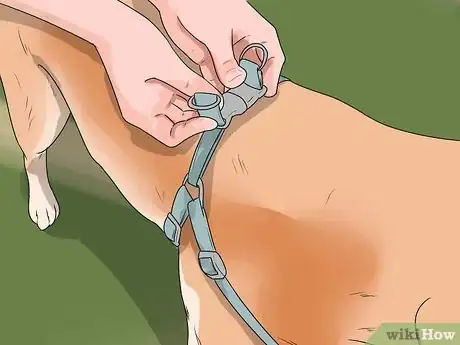
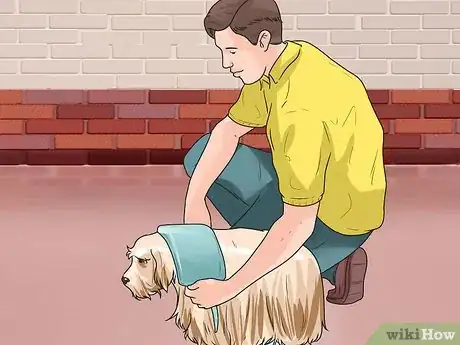

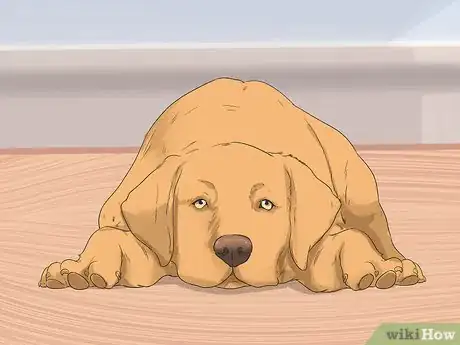
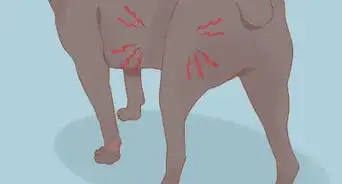
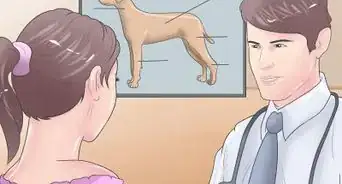
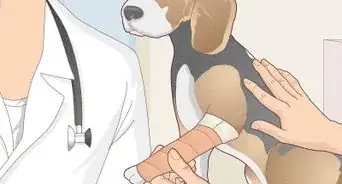
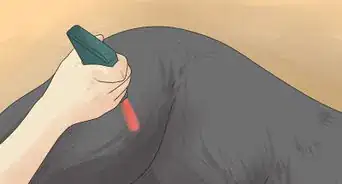
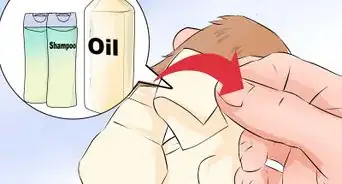
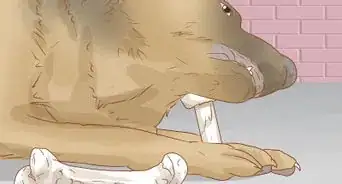

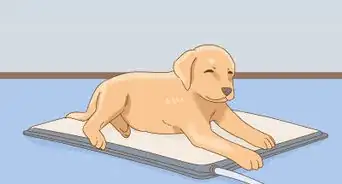
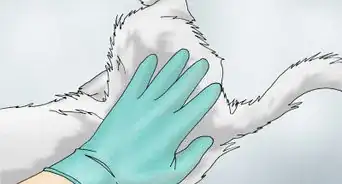
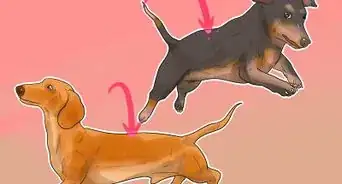
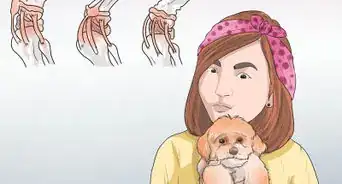














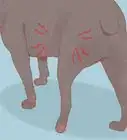
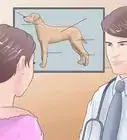
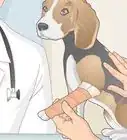





































Medical Disclaimer
The content of this article is not intended to be a substitute for professional medical advice, examination, diagnosis, or treatment. You should always contact your doctor or other qualified healthcare professional before starting, changing, or stopping any kind of health treatment.
Read More...